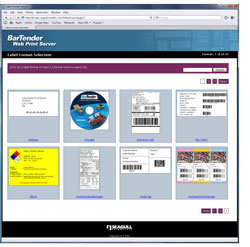Barcoding News
Data tracking news, product updates, tips, and more
Intermec Announces 70 Series Mobile Computers: CN70, CN70e, CK70 & CK71
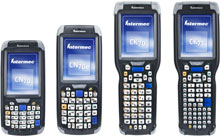 The Answer to the Industry’s Need for No Compromise Rugged Mobile Computing
The Answer to the Industry’s Need for No Compromise Rugged Mobile Computing
Intermec announced the launch of the 70 Series, its next generation portfolio of ultra-rugged mobile computers, delivering unparalleled performance to maximize worker uptime and efficiency. Comprised of four products over one platform, the Intermec 70 Series nearly doubles Intermec’s mobile computer portfolio in one release.
With 45 years of technology innovation as its foundation, the Intermec 70 Series comprises four distinct products sharing a common platform and capabilities:
- CN70 – field service, transportation and logistics
- CN70e – direct store delivery/route accounting
- CK70 – parcel delivery in courier, express and postal operations
- CK71 – manufacturing and warehousing
All in the smallest and lightest form factors in their respective classes, each product is built to help businesses optimize resources to improve operational efficiency, support future growth, and deliver high customer satisfaction.
Motorola Introduces DS9208 Barcode Scanner, DS4208 Barcode Scanner and MC9190-G Mobile Computer
New mobile computing, voice and imaging solutions help bring the right information to the right place at the right time
Motorola Solutions introduced today the DS9208 presentation imager, DS4208 handheld imager, MC9190-G industrial mobile computer and announced TEAM Express push-to-talk communications as a standard feature across its portfolio of voice-capable mobile computers.
New DS9208 presentation imager and DS4208 handheld imager
- The new hands-free DS9208 presentation imager is a sleek, compact and affordable bar code scanner offering excellent performance on 1D and 2D bar codes used in traditional and mobile bar code applications.
- The new DS4208 handheld bar code imager is intuitive, easy-to-use and quickly reads 1D and 2D printed bar codes on paper or from a cell phone display offering retail customers a truly affordable handheld 2D imager that can enhance their business.
- Both the DS4208 handheld imager and DS9208 presentation scanner are based on a brand new imaging technology platform from Motorola Solutions that can quickly read bar codes from traditional paper labels and hang tags, as well as from cell phones supporting mobile couponing, mobile loyalty and mobile gift card applications. The DS9208 is offered with an optional on-board parsing engine to read and parse PDF417 bar codes on United States driver licenses.
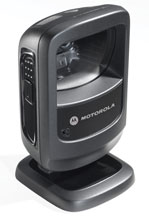 Â Â Â Â
    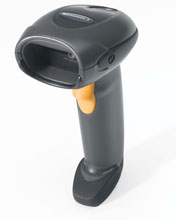
 MC9190-G Rugged Mobile Computer
MC9190-G Rugged Mobile Computer
- Building on the industry’s single best-selling rugged mobile computer, Motorola Solutions’ new MC9190-G series of industrial mobile computers provides a multitude of keypad and scan engine options, including a new long-range imaging option that offers revolutionary standard 1D and 2D bar code reading up to 30 feet, as well as image capture capabilities to meet the emerging requirements for 2D bar code reading in retail and warehouse applications.
- The MC9190-G leverages the design of the MC9000 series and incorporates new features, including a more rugged touchscreen and scanner exit window. In addition, the MC9190-G offers a common platform with the MC9000 providing fast porting of applications and backward compatibility with all accessories.
- Motorola’s newest industrial mobile computer includes an integrated RFID tag to help customers track their MC9190-Gs throughout the enterprise – eliminating lost or misplaced devices.
TEAM Express Voice Solution
- Throughout 2011, Motorola Solutions will introduce the Total Enterprise Access and Mobility (TEAM) Express solution as a standard feature across its broad portfolio of voice-capable mobile computers.
- TEAM Express enables fast, easy push-to-talk communications among multiple, disparate devices, including Motorola voice-capable mobile computers, two-way radios and TEAM devices to help improve employee accessibility, responsiveness and productivity.
- Completely server-less and deployed through a simple set-up, TEAM Express leverages existing IT investments and can also interoperate with two-way radios using the TEAM Radio Link Solution (RLS).
These products are backed with the complete range of Motorola services, from advanced services to help plan and deploy the next generation of enterprise mobility to ongoing support with Service from the Start with Comprehensive Coverage.
Epson Introduces TM-H6000IV Multifunction Receipt Printer

Fastest Check Processing and Most Energy Efficient In Its Class, Ideal for High-Volume Retailers
Today at the National Retail Federation (NRF) 100th Annual Convention & Expo, Epson introduced the TM-H6000IV – a multifunction POS printer ideally suited for retail and supermarkets looking to speed checkout lanes, increase productivity and save on energy costs. With best-in-class reliability, forms handling, the industry’s fastest check processing and the fastest print speeds in its class, up to 50% faster than the prior model, the TM-H6000IV is ideally suited for retailers looking for fast-moving checkout lanes. In addition, the TM-H6000IV is the industry’s first ENERGY STAR® qualified hybrid printer, has the lowest power consumption in its class, is up to 84% more energy efficient than its tested competitors1, and has print options that can reduce receipt paper usage over 25%.
TM-H6000IV Features and Benefits
Designed with even greater reliability and a smaller footprint than the previous model, Epson’s new TM-TH6000IV offers the following features and benefits:
-
Transaction Speed
With printing up to 300mm/second, the TM-H0000IV is 50% faster than the TM-H6000III and offers the fastest print speeds in its class as well as the industry’s fastest check processing. -
Reliability
With an MCBF of 96 million lines the TM-H6000IV is the most reliable in its class and all components are designed to last the lifetime of the printer. -
MICR Accuracy
Epson’s TM-H6000IV MICR leads the industry with over 99.9% accuracy and reads more of the check surface than the prior model, reducing the number of unreadable checks. -
Environmental Features
The TM-H6000IV is ENERGY STAR qualified, has the lowest power consumption in its class and offers print options that reduce receipt paper usage over 25%. -
Easy System Integration
With Epson’s advanced Connect-It® interface modules, the TM-H6000IV is compatible with the latest systems and many legacy systems. The TM-H6000IV comes with dual interfaces (a built-in USB and one additional interface) to ensure easy integration. -
Warranty and Availability
Backed by world-class service and support programs and a two-year warranty, the TM-H6000IV is ideally suited for fast, high-performance retail printing applications and will be available Q1 2011.
Datalogic Falcon X3 Mobile Computer
Power³ technology gives the new Falcon™ X3 from Datalogic Mobile the power and features to tackle applications required by today’s high speed supply chains.
The new Datalogic Falcon X3 provides real time data capture and communication, assuring accurate inventories and maximizing productivity. Available with either laser scanner or 2D imager, the Falcon™ X3 can be configured to match the needs of any department. Both laser and imager come with Datalogic patented Green Spot good read feedback assuring accuracy. Packaged with Windows CE or Windows Mobile 6.5, the Falcon™ X3 integrates seamlessly with WMS and ERP management systems. Plus, the Falcon™ X3’s Summit Wi-Fi 802.11 a/b/g radio provides maximized coverage, thanks to a unique diversity antenna system.
Attention to ergonomics is seen throughout the Falcon™ X3. The pistol grip version offers an arched handle and ergonomic trigger, making high frequency scanning operations comfortable throughout the day. The numeric and alphanumeric keyboards are set up placing high use keys at the operator’s fingertips, with a universal numeric phone key layout. The crisp QVGA display and backlit keyboard make it easy to work in dark indoor or extremely bright outdoor environments. The Falcon™ X3 is built rugged, resisting numerous drops from 6 feet, while IP64 level sealing protects the unit from dust and liquids.
Datalogic Mobile’s software and service tools complete the new Falcon™ X3 with preloaded and pre-licensed Wavelink® Avalanche™ and Terminal Emulation. This makes the mobile computer ready to go out of the box for rapid deployment and centralized management. Other software tools included are the Datalogic Desktop, Configuration, and Firmware Utilities to customize and update device configuration.
Datalogic Mobile also offers a comprehensive suite of maintenance service programs to protect the Falconâ„¢ X3 investment.
Major Upgrade of Seagull BarTender Web Print Server Released
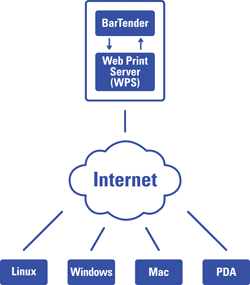
In addition to Internet Explorer, BarTender Web Print Server now supports Firefox, Chrome, Opera, and Safari (shown). |
Seagull Scientific released version 9.3 of BarTender Web Print Server (“WPS”) in November, 2010. This web application, originally introduced with the release of BarTender version 8.0 back in 2007, allows users to select and print BarTender label formats from within web browsers instead of BarTender. (Although BarTender Web Print Server is free, it requires use of the Enterprise Automation edition of BarTender.)
Some of the many enhancements in the new version of Web Print Server:
- ActiveX No Longer Required for Internet Printing
When using a printer connected by LAN or WAN to the Web Print Server server, Web Print Server has always supported print requests from a variety of browsers running on different hardware platforms and operating systems. We refer to this as “Standard Windows Printing.”Until now, however, printing over the internet (instead of a LAN or WAN) required that the client be a Windows PC running Internet Explorer and ActiveX. It also required that Windows printer drivers be installed on the client PC.
The new version of Web Print Server now supports Internet Printing using many more operating systems, browsers, and driver options for clients, including:
- Printer Drivers Now Optional!
Using the new Direct-to-port Internet Printing option, you no longer need to have a printer driver installed on the client. Instead, the print code can be routed directly through the browser to the printer port. - New Java Client-side Print Module
Our long-established ActiveX Client-side Print Module is still provided and supported. However, a Java Client-side Print Module is now offered as well, providing support for a wider variety of browsers and operating systems. - Support for Firefox, Chrome, Opera, Safari Browsers
The new Java Client-side Print Module enables support for additional browsers besides just Internet Explorer. This includes Firefox, Chrome, Opera, and Safari. - Support for Linux and Mac OS X Clients
Internet Printing is now supported using Linux and Apple Macintosh OS X clients in addition to Windows clients. - Supports New Data Entry Controls
BarTender v9.3 added support for several new types of controls for use on data entry forms, including checkboxes, radio buttons, and additional list controls. Version 9.3 of Web Print Server now supports these additional controls as well.

Barcode Keyboard for Android Lets You Scan Wherever You Can Type
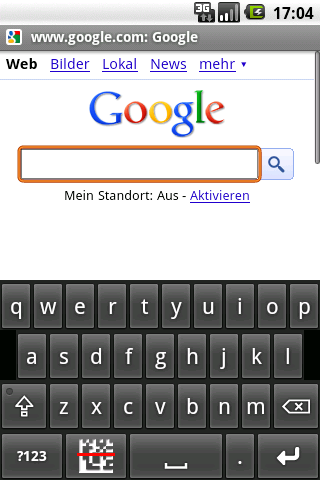
Barcode Keyboard app from TEC-IT replaces the standard on-screen keyboard on your Android device with one that includes a barcode key. Clicking the barcode key uses your phone’s camera to make snap a picture of a barcode and then automatically enters the decoded contents of the barcode wherever the cursor is located.
The Barcode Keyboard software also supports advanced setting like data prefixes and suffixes (characters that are automatically entered before or after the scanned barcode).
This software helps convert your Android phone into a very basic barcode scanner.
AirScan Wireless Barcode Inventory Scanner for iPhone

lividbox.com has just released AirScan for iOS devices with auto-focus cameras (iPhone 3GS, iPhone 4, and 4th generation iPod touch).
In contrast to the many “barcode scanner” apps in the App Store that are designed only for price checking, AirScan allows you to use your iPhone/iPod as a wireless barcode scanner. Barcodes scanned with the software are sent wirelessly to a computer “base station” (running a special, free, iBarcode server). Barcodes can also be saved to the clipboard on your iPhone.
Zebra RW 420 Route Palette integrates Motorola’s MC9500 Series Mobile Computers
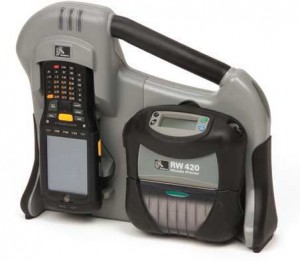 Zebra announces the release of their next version of rugged RW 420 Route Palette. This integrated carrying device is designed to work specifically with Motorola’s new MC9500 industrial grade mobile handheld computer. Ideal for route accounting, direct store delivery or field service and sales operations, the RW 420 brings efficiency and ease-of-use to field mobility applications, saving valuable time and money.
Zebra announces the release of their next version of rugged RW 420 Route Palette. This integrated carrying device is designed to work specifically with Motorola’s new MC9500 industrial grade mobile handheld computer. Ideal for route accounting, direct store delivery or field service and sales operations, the RW 420 brings efficiency and ease-of-use to field mobility applications, saving valuable time and money.
Designed to handle the harsh demands of mobile computing in the field, the RW 420 Route Palette is the most rugged of its kind, with an Ingress Protection (IP) rating of IP 42, making it resistant to certain environmental conditions, such as moisture, dust and dirt.
Free Inventory, Asset Tracking, Data Collection and Order Entry Apps for Datalogic Windows Mobile Computers
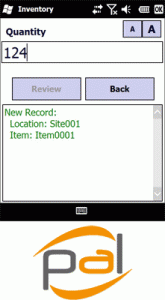 Datalogic has just introduced “Pal”, a free suite of simple data collection apps for all Windows CE & Windows Mobile based Datalogic handheld computers.
Datalogic has just introduced “Pal”, a free suite of simple data collection apps for all Windows CE & Windows Mobile based Datalogic handheld computers.
Pal apps are compatible with Memor, Elf, Falcon 4400 series, Pegaso, J Series, Kyman and Skorpio mobile computers.
Right out of the box, Pal makes it easy to collect data, transfer it, view on your mobile computer, and load it into an Excel spreadsheet.
The Pal suite of apps includes:
- Shelf Inventory – Perfect for performing a physical inventory or cycle counting in your store or warehouse. Data collected includes location, SKU and quantity.
- Asset Tracking – Quickly and easily take an asset inventory. Data collected includes location and asset.
- Shelf Replenishment – Instantly generate a pick list to replenish low shelf stock. Data collected includes store, shelf ID, SKU and quantity.
- Order Entry – Place an order in the field to replenish stock. Data collected includes site, order id, SKU and quantity.
- Communicator – Pal Communicator is a PC application that allows the transfer of data on demand or automatically between your PC and a Datalogic handheld. This utility also provides features data viewing in Excel, or Notepad.
The apps are ready to use, but can also be configured to meet your specific needs.
Download free Pal data collection apps for Datalogic mobile computers
Delivering Efficiency: Streamlining Pick-Up and Delivery in the Post & Parcel Industry
Introduction
In today’s fast-paced post and parcel industry, streamlined efficiency is more important than ever. Often times, however, the determining factors are out of our control.
Many of the most technologically-advanced delivery companies in the world still pick up a relatively high percentage of their items without prior knowledge of the destination or any other delivery element prior to taking physical control of the item.
When challenged, some of the most advanced companies in the world found “surprises†like these are accounting for as much as 10-25 percent of the items they are picking up. That is as much as 25 percent of their business they don’t know about in advance – meaning they can’t plan for downstream processes, in turn eliminating much (if any) chance to do dynamic network optimization or downstream labor planning. That also means as much as 25 percent of their business also requires someone to sit in front of a computer to manually enter the shipping details, including the delivery address, which they tell us can take in excess of one minute per package – ultimately costing millions of dollars each year. If they want any chance of advanced notice on the shipment and true tracking from the point of pickup, it entails having their most expensive resource, the courier, enter the data on their mobile computer. Our customers have found that these methods are not only time consuming, but very error prone as well.
And, due to decreasing work forces and overall increased productivity issues, delays and other shipping errors are further decreasing customer satisfaction. According to a 2009 Gallup Poll, the U.S. postal industry alone has lost $8 billion since 2007. In order to be successful in such challenging times, industry leaders must find ways to both increase revenue and reduce costs. To mitigate these issues, post and parcel industry operators are actively pursuing new technologies to help enhance profitability, while also increasing visibility and planning capabilities through the elimination of errors. New technology solutions may hold the key to solving this issue.



